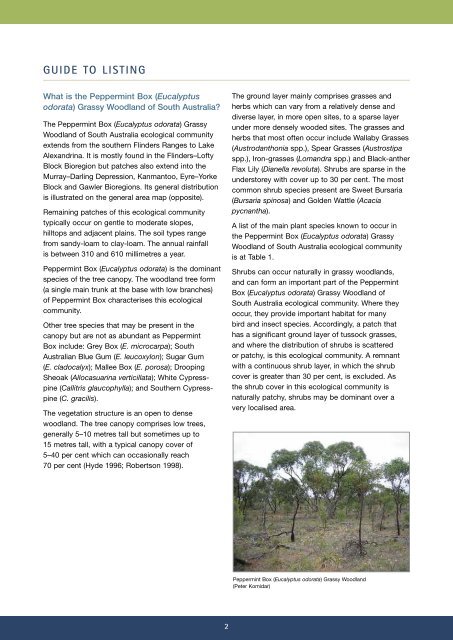Peppermint Box (Eucalyptus odorata) - Department of Sustainability ...
Peppermint Box (Eucalyptus odorata) - Department of Sustainability ...
Peppermint Box (Eucalyptus odorata) - Department of Sustainability ...
You also want an ePaper? Increase the reach of your titles
YUMPU automatically turns print PDFs into web optimized ePapers that Google loves.
GUIDE TO LISTING<br />
What is the <strong>Peppermint</strong> <strong>Box</strong> (<strong>Eucalyptus</strong><br />
<strong>odorata</strong>) Grassy Woodland <strong>of</strong> South Australia?<br />
The <strong>Peppermint</strong> <strong>Box</strong> (<strong>Eucalyptus</strong> <strong>odorata</strong>) Grassy<br />
Woodland <strong>of</strong> South Australia ecological community<br />
extends from the southern Flinders Ranges to Lake<br />
Alexandrina. It is mostly found in the Flinders–L<strong>of</strong>ty<br />
Block Bioregion but patches also extend into the<br />
Murray–Darling Depression, Kanmantoo, Eyre–Yorke<br />
Block and Gawler Bioregions. Its general distribution<br />
is illustrated on the general area map (opposite).<br />
Remaining patches <strong>of</strong> this ecological community<br />
typically occur on gentle to moderate slopes,<br />
hilltops and adjacent plains. The soil types range<br />
from sandy-loam to clay-loam. The annual rainfall<br />
is between 310 and 610 millimetres a year.<br />
<strong>Peppermint</strong> <strong>Box</strong> (<strong>Eucalyptus</strong> <strong>odorata</strong>) is the dominant<br />
species <strong>of</strong> the tree canopy. The woodland tree form<br />
(a single main trunk at the base with low branches)<br />
<strong>of</strong> <strong>Peppermint</strong> <strong>Box</strong> characterises this ecological<br />
community.<br />
Other tree species that may be present in the<br />
canopy but are not as abundant as <strong>Peppermint</strong><br />
<strong>Box</strong> include: Grey <strong>Box</strong> (E. microcarpa); South<br />
Australian Blue Gum (E. leucoxylon); Sugar Gum<br />
(E. cladocalyx); Mallee <strong>Box</strong> (E. porosa); Drooping<br />
Sheoak (Allocasuarina verticillata); White Cypresspine<br />
(Callitris glaucophylla); and Southern Cypresspine<br />
(C. gracilis).<br />
The vegetation structure is an open to dense<br />
woodland. The tree canopy comprises low trees,<br />
generally 5–10 metres tall but sometimes up to<br />
15 metres tall, with a typical canopy cover <strong>of</strong><br />
5–40 per cent which can occasionally reach<br />
70 per cent (Hyde 1996; Robertson 1998).<br />
2<br />
The ground layer mainly comprises grasses and<br />
herbs which can vary from a relatively dense and<br />
diverse layer, in more open sites, to a sparse layer<br />
under more densely wooded sites. The grasses and<br />
herbs that most <strong>of</strong>ten occur include Wallaby Grasses<br />
(Austrodanthonia spp.), Spear Grasses (Austrostipa<br />
spp.), Iron-grasses (Lomandra spp.) and Black-anther<br />
Flax Lily (Dianella revoluta). Shrubs are sparse in the<br />
understorey with cover up to 30 per cent. The most<br />
common shrub species present are Sweet Bursaria<br />
(Bursaria spinosa) and Golden Wattle (Acacia<br />
pycnantha).<br />
A list <strong>of</strong> the main plant species known to occur in<br />
the <strong>Peppermint</strong> <strong>Box</strong> (<strong>Eucalyptus</strong> <strong>odorata</strong>) Grassy<br />
Woodland <strong>of</strong> South Australia ecological community<br />
is at Table 1.<br />
Shrubs can occur naturally in grassy woodlands,<br />
and can form an important part <strong>of</strong> the <strong>Peppermint</strong><br />
<strong>Box</strong> (<strong>Eucalyptus</strong> <strong>odorata</strong>) Grassy Woodland <strong>of</strong><br />
South Australia ecological community. Where they<br />
occur, they provide important habitat for many<br />
bird and insect species. Accordingly, a patch that<br />
has a significant ground layer <strong>of</strong> tussock grasses,<br />
and where the distribution <strong>of</strong> shrubs is scattered<br />
or patchy, is this ecological community. A remnant<br />
with a continuous shrub layer, in which the shrub<br />
cover is greater than 30 per cent, is excluded. As<br />
the shrub cover in this ecological community is<br />
naturally patchy, shrubs may be dominant over a<br />
very localised area.<br />
<strong>Peppermint</strong> <strong>Box</strong> (<strong>Eucalyptus</strong> <strong>odorata</strong>) Grassy Woodland<br />
(Peter Komidar)
















